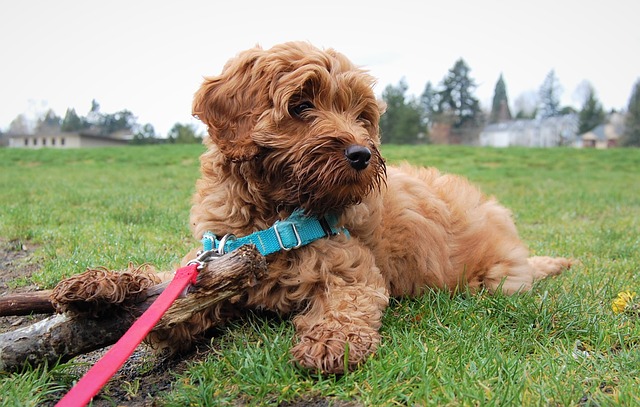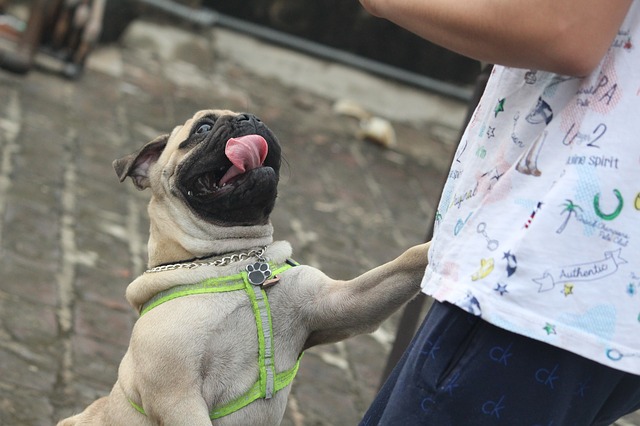The question of whether to use a collar or harness when walking your pup is an important one. It’s hard to resist the limitless colors and designs of personalized collars, but choosing what’s best for your dog should be about more than style. Collars are great for identification and holding your dog’s name tag and registration, but they’re not right for every situation. For many dogs, a harness is the best way forward when it comes to a daily walk. Here’s why.

1. Better Control
Not every dog is a perfect angel on the leash. They like to dive after surprised birds, lunge toward dogs they meet on the sidewalk, and make continual efforts to trap the neighbor’s cat. They’re having fun, but that rowdy behavior can also get them into trouble.
Harnesses give the person on the other end of the leash better control of an active dog. Instead of trying to steer by pulling the dog’s neck, harnesses direct the dog’s entire body. People with big, rambunctious dogs especially benefit from greater control when walking through busy areas when the dog is extra excited.
Related: 10 Best No-Pull Dog Harnesses (Plus 1 to Avoid)
2. Discourages Pulling
You’re the one that should be walking your dog, not the other way around. A dog’s incessant pulling on the leash can make a short walk down the road feel like an intense upper body workout. If you let them get away with it, you teach them that pulling your arm out of its socket is an effective way of getting what they want. You’re struggling to keep up, but they’re making forward progress. Harnesses discourage pulling by redirecting their momentum. Dogs learn when they pull against the leash that the harness will haul them in the opposite direction of where they want to go. AKC writes,
“When your dog is wearing a collar and pulls on the leash, he’s still moving forward, which makes him think the pulling is successful. A harness, whether attached on his chest or between his shoulder blades, redirects him; there’s no reward because pulling doesn’t get him anywhere.”

3. Reduces Neck Strain
When your dog pulls while wearing a collar, injury to your arm isn’t your biggest concern. Pulling puts intense strain on the dog’s neck and can easily lead to a serious injury. Many times, these injuries aren’t obvious. It’s more of a gradual deterioration than a sudden pain. Excited dogs are too concerned with what they’re doing to realize they’re actually hurting themselves. The dog might start showing signs of subtle discomfort that are actually early symptoms of a serious problem.
Small dogs like Chihuahuas and Miniature Pinschers are especially prone to neck injuries. The bones in their necks are extremely delicate, and one sharp pull on the leash can cause them a lot of pain. Harnesses disperse the strain across a larger area of the dog’s body to protect them from injury.
4. Ocular Proptosis in Certain Breeds
In basic terms, ocular proptosis is when the dog’s eyeballs protrude out of the sockets. It’s easy to diagnose, because it literally looks like the dog’s eyes are bulging out of their head and beyond their eyelids. Pet Health Network says it’s usually caused by blunt trauma to the head, but for certain dog breeds, too much strain around the neck can also be the issue. They say,
“Brachiocephalic breeds, such as Pugs, Pekingese, Shih Tzu, and Lhasa Apso, are predisposed to protopsis due to their shallow orbits.”
Collars are often to blame, but using a harness is an easy way to protect dogs from this painful and dangerous condition.

5. Danger of Escape Artists
The general rule for collars is you should be able to fit two fingers between the material and the dog’s body. This is to prevent the collar from being too tight and hurting the dog. Determined dogs, however, know how to take advantage of a comfortable collar. One second you’re chit chatting with the neighbor, and the next your pup is sprinting down the street after maneuvering the collar up and over his head.
Dogs with thick necks and smaller heads and dogs that are especially wiggly can easily escape from collars while on walks. This poses obvious safety issues. Harnesses, on the other hand, cover the body and are securely fitted in place. They go around the shoulders, front legs, and chest to make escaping impossible.
6. Respiratory Problems and Neck Injuries
Any kind of strain on a dog’s neck has potential to be painful, but dogs with existing respiratory problems and neck injuries are particularly at risk. Extra pressure around the neck squeezes the dog’s windpipe and can make breathing difficult. Many dogs end up having coughing fits as a result of being led on walks by their collar.
Tracheal collapse is another chronic disease that can be worsened by wearing a collar. It usually happens in small breed dogs where the cartilage that makes up the trachea is either weakened or malformed. The result is a restricted airway, and these dogs need to wear harnesses on walks to keep pressure off their sensitive necks.
To make the best use of a dog harness, it’s important to choose the type and style that’s most appropriate for your dog. There are several options available, and they’re designed for dogs of different sizes, personalities, and training levels. Dogs that love to pull, for example, best benefit from harnesses where the leash is clipped to the chest rather than the back. There are even harnesses with built-in cool packs to keep pups from overheating on hot days. Research the different options to make walking with your dog safer and more pleasant for both of you.
h/t: AKC, Pet Health Network
Feature Photo Credit: Photo by NICOLAS TESSARI on Unsplash
 Toledo, United States.
Toledo, United States.